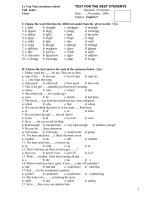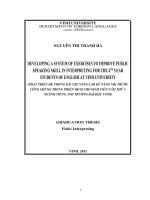Fast fluency communication in english for the international age
Bạn đang xem bản rút gọn của tài liệu. Xem và tải ngay bản đầy đủ của tài liệu tại đây (8.96 MB, 92 trang )
Communication in English
for the International Age
thi
William Boletta
Logos International
To
The Student
| eee ey arse ional
very much by itself,We use language to express thoughts
not worth
alone aresnot asimportant asthe
or feelings. Grammar and word
content of what you say. In fact, without content and meaning,
language would be useless.
Language, then, isawayto communicate what youneed,
‘want, think, or feel. This i true of all languages, not only English.
‘Your native language and English are very similar. Both are used
to communicate with other human beings. This is true of all
languages in all countries
How can I learn to speak English?
y learn itasa second
English is nota mystery or secret. Anybodcan
language, and millions of people do every year, but ifyou want to
be willingtto do two things: Make
earn to speak English, you mus
mistakes and take chances.
‘When you speak English, you will make some mistakes
because nobody can start speaking a foreign language perfectly
from the start. you wait until you know all the words and forms
perfectly, you will never be able to speak English. So start now,
speak the best way
andes,
‘wherever you are in your English studi
you can. You can learn new words and better grammar later, but
if you don’t start talking now, you will never improve.
‘This is why it is important to take chances. If you wait
‘until you are sure that everything you say will be perfect, you will
‘wait a long time. Maybe forever! Don't be afraid to say what you
want to—now. Ifyou make a mistake this time, that’s O. K. Ifyou
are shy at first, don’t worry. The next time it will be easier. The
more mistakes you make and the more chances you take, the
casier it will be to speak without fear.
‘What about grammar? What happens if you don’t speak
correct English? Of course, sometimes people might not always
d with speakers ofour native language, we
you, buteven
‘understan
often need to explain things in a different way. If people don’t
‘understand what you say at first, you can try it again a different way.
another person, youcan ask them again,
‘Andifyoudon'tunderstand
and they wil usualy explain it another way until you understand.
If you want
to speak Eng-
lish, you must
be willing to
do two things:
Make mistakes
te denc?
and
To the Student xiii
Will this book help me?
Fast Fluency is filled with interesting communication activities
that give you an opportunity to use your English to talk about all
sorts
of things, But you can’t simply read it, you must speak with
“Learning to
other people.
speak a lanIf you study the conversations and variations in these
guage can be a
lessons, practice speaking with your classmates, and discuss the
great adventopics given in this book, your English will definitely improve.
ture—f you are
You
can learn to read a language alone in your room, with a
willing to be a
little daring. dictionary and a grammar book, but you cannot learn to speaka
langua
by yourself
ge . You must havea conversation parttoner
talk
with and something interesting to talk about.
Language and life are always full of surprises. When you
are having a conversation with someone (in any language) you
never know what the other person is going to say next. And ikelife
itself, learning to speak a language can be a great adventure—if
you are willing to be a little daring and take a few chances. It
doesn’t matter how good orb
yourad
spoken English isnow. Ifyou
study the material here and practice with your classmates, it will
get better. That is a guarantee. Will your English be perfect? Of
course not, but it will improve and you will have much more
confidence and speaking ability when you finish this book. I hope
you enjoy it. Good luck!
xiy Fast Fluency
To
The Teacher
pe
should provide students
with language they can use and it should furnish something they
cantalkabout.
This bookstrivesto do both by offeringthestudent
concrete language and adult subject matter useful for communicating in contemporary, everyday English.
‘Mostofus havenever found the perfecttextbook,and this
‘one doubtless has its faults too, but I have tried to steer a course
between the two extremes of conversational textbooks as I see
them: an overabundance of content on the one hand and a
concentration on structure to the detriment of communication
and meaning on the other. While the assumption here is that
students already have a basic working knowledge of English
structure and lexicon, there is a consistent attempt to make
students familiar with some of the most important functions and
patterns of spoken English.
‘The premise of the book is that language is communication, not puzzle, nota complexsystem ofrules, nota medium for
testing intelligence. The purpose of language is to communicate
with other people on subjects
of mutual interest to the speakers,
whether that be finding out where the bus stops or discussing
‘geopolitical issues. In this spirit, Ihave tried to givestudentsample
material for practicing
basic survival English as wellas for expressing themselves on a wide variety of subjects.
‘Thereare twenty lessons, and teachers may cover them in
any order. Theyarenot graded, and each one contains
very simple
a well as more difficult and less frequently-used language items.
While there is a certain logic to the presentation of the subject
matter ofthe conversations, thelevel ofdifficulty remains moreor
less uniform throughout. Early lessons treat greetings, introductions, and small talk—topics and functions which often occur
carly in relationshipsor in initial encounters with strangers—but
they need not be covered during the first few weeks
of the course.
Itisnot always
easy for students to deal with these social functions
carly inthe course when they are still uncomfortable talking with
their classmates and may likely not even know them. These
pedagogical matters are, of course, up to the individual teacher to
“Language is
communica-
n, not a
puzzle, not a
complex system of rules,
not a medium
for testing
intelligence.”
To the Teacher
xv
decide. While the structural patterns and functional applications
introduced throughout reflect the author's own preferences and
experience, there was some effort to cover a repertoire of basic
communication needs
as suggested in standard inventories such
as Van Ek and Alexander's
Pergamon Press, 1975).
Threshold Level English (Oxford:
Each lesson hasa uniform format consisting of five parts:
Conversation
Variations
Your Turn
Sharing
‘Try Your Hand
“Each lesson
has:a uniform
format
brief summary of the format and character of each
consist-
tion with a few suggestions for teaching strategies.
parts.
Conversation
ing of five
‘The “Conversation” sections which open each lesson secktobeas
authenticas possible, with no artificial language. Amajor problem
confronting the author of a conversational textbook is deciding
which reisterto pitch the conversationsat. While there are some
examples of more formal English in many kinds of situations,
including politeness language when talking to strangers, 1 have
hoped to avoid the wooden quality that castsa pall of artificiality
over so many textbooks which have the goal of teaching spoken
English. Endeavoring to avoid cold and priggish textbook language that nonativespeakersin their right mind would
ever utter,
Ihave frequently included colloquial expressions such as “yeah,’
“uh, hub,” *hmm,”“et’s see,” and many other such pause mark‘ersand speech fillers. They remain opaque and lifeless on the page,
cof course, until the teacher models how they occur in an organic
conversational and social context.
‘Also, though few textbooks ever take cognizance of it,
English speakers quite frequently omit subject pronouns, par-
ticularly “I.” Occasionally, I have tried to reflect this and other
the side of being to0 colloquialat times, I hope that teachers and
‘students alike will find this transgression at least more desirable
in the greater scheme of things than reinforcing the idea that
spoken English is a robot-like language devoid of contractions,
reduced forms, casualexpressions,and—ultimately—bled
dry of
‘such elliptical tendencies in the conversations. If have erred on
its lifeblood.
xvi Fast Fluency
"“——————
Variations
Immediately following the conversations in each lesson are six
specific locutions drawn from the opening conversation along
with examples of how they can change in everyday conversation,
They are often picked up and practiced in subsequent exercises,
frequently supplying much of the language used in the commut
cative exerciseslater in thelesson. By design, no directions accompany either the “Conversations”
or the “Variations.” Teachersare
thereby at liberty to introduce and use the material in a variety of
ways according to their own taste and style and the needs of
individual classes,
‘Some teachers might be surprised to see what appear to be
‘chimericspecters
ofthe Audiolingual Method comeback to haunt us
inthe form of pattern practicesin disguise.
The premises upon which
this textbook are based differ drastically, of course, from orthodox
ALM theory. Having been a student in French and German classes
taught via the ALM in thefifties, and later teaching those languages
‘myselfthrough
the ALM, Iam definitely not espousingaretum tothe
untinctured
version ofthatapproach. After teaching communicative
ESL/EFL materials for several years, however,and observingstudents
sometimes bewildered bya lack of specificity
and definite languagein
many communicative textbooks, I saw a need for some concrete
examples of the shape of English which can serve students as a
‘conversational life preserver to embrace when they find themselvesat
sea conversationally. The pedagogical purpose of the “Variations”,
then, isto establish
a sense of comfort with turns of phrase common
inspoken English by giving students. feeling for the contoursofthe
vyernacularand helping them to develop an awareness
of the kinds
of variation possible,
While the patterns have the same format on the page (a
combination of boldface and italic typefaces), there are actually
ingelement (in boldface) with varied extensions (in italics). The difference lies in
where the emphasis is. Frequently the main item of study is the
unchanging boldface element. Such as the following (from
Lesson 7):
“Teachers are
at liberty to
use the
rial in a
of ways
cording
matevariety
acto
their own
taste and
style.”
Is there a department store around her
a bakery
a supermarket
a sporting goods store
alibrary
Less frequently, the main focus is on the italic clement, and
‘To the Teacher xvii
synonymous expressions appear as variations,
asin the following
example (from Lesson 20):
How about you, Pedro?
what about you
and you
how do you feel about that
what do you think
“We some-
times
how intimidating pairwork
can be for
students who
have but a little
conversational
facility.”
‘The“YourTurn” section hasan overtly communicative focusand
is, in many respects, the heart of the textbook. Pair and group
materials furnish a context for practicing the language or subject,
matter of each lesson, concentrating mainly on the functional
language necessary for everyday survival (directions, requests,
compliments, and the like).
In this section, students are asked to do a variety of
ies designed to get them totalk
to each otherin English using
whateverlinguistichooksand crooksthey
can comeup with. They
are not completely abandoned, however, for there are numerous
‘suggestions for specific turns
of phrase they can use, and language
material gleaned from the “Conversations” and “Variations”
portions of the lesson usually finds a natural fit here.
As teachers, we sometimes forget how intimidating
pairwork
can be for students who have buta little conversational
facility. Many dyad and group activities appear deceptively simple
and self-explanatory, but it is a risky pedagogical practice to
supplya topic, picture, or activity, and then simply leave students
to their own devices. In spite of its enshrinement as the reigning,
modality of communicative activities in the ESL classroom,
pairwork is still not conventional communication. It simulates
real communication, but it is not always a perfect match. As
authenticas we might try to make communication
activities in the
classroom through developing materials and structuring the atmosphere ofthelocation, inevitably alingeringartificiality
remains.
Therefore, exhaustive demonstration of how to do the pairwork
activities isessential, and theinvolved teacher will monitorstudent’s
activities, coaching and supporting them with suggestions, hints,
and encouragement.
Sharing
xviii Fast Fluency
‘The “Sharing” section introduces mature material for reflection
and discussion. In keeping with the book’s subtitle, Communication in English for the International Age, the themes introduced
here have a global and cross-cultural flavor. There is also some
os
Your Turn
attempt at sociolinguistic consciousness-raising, presented in the
form of questions for small group work.
Ifthe “Your Turn” section is the meat of the lesson, then
surely
the “Sharing” section must be the dessert. Herestudentsare
asked to move beyond the classroom and talk about real life, the
world around them, and their own experience. Each section
begins with a brief note pointing out some cultural aspect of
English and English-speaking society or broader, international,
socio-cultural topics. Then the students are asked to discuss with
their classmates a variety of topics. The subject matter is usually
related (ifsometimes only loosely) to the material of the opening
conversation. The scope of the topics is uniform for each lesson
and expandson the subject matter, inviting students ohare their
‘own experience.
‘There are three general sets of topics
for discussion wh
appear consistently in the following order in each lesson:
I. Discussion topics which ask students to look at the
customs of their own country. These opening reflections
and discussions give students a grounding in their home
culture which they can then use as a springboard to leap
into adiscussion of sociolinguistic and cultural contrasts
ina more global context.
“Teacher
intervention
in modelling
how to carry
sion is cru-
ial
*®
Il. Topics which encourage thestudentsto share details of
theirown pastexperience
visa visthe subject matter ofthe
lesson. The emphasis here is on sharing personal impres-
sions and feelings.
IIL. Topics which allow students to expand on their own
experience
by using their imagination
or by seeing things
in a broader, international context. This section sometimes suggests a certain fantasy situation or otherwise
invites the student to engage in hypothetical thinking or
to contemplate global issues.
While the material provided for conversational discussion here and elsewhere in the book is sometimes difficult, it
strives always to be challenging and stimulating at an adult level.
Once again, teacher intervention in modelling how to carry ona
discussion is crucial here. One suggestion for structuring the
discussion would be to divide the class nto small groupsand have
each group select a discussion leader (rotating with each class
meeting) and ascribe who takes notesand reportsto the class later
To the Teacher
xix
“The purpose
of the writing
exercises is to
solidify conversational material already
learned and
give the students a feeling
of confidence,
security, and
accomplish-
ment.*
onthe group's discussion. Without such structuringand
frequent
assistance by the teacher, students at this conversational level can
quickly lose their focus.
‘Try Your Hand
The last section of each lesson has material for reading and
vocabulary enrichment along with three short writing exercises.
‘The material here ranges from letters, schedules, word lists, a
menu, and a resumé to cultural matters, technology, and new
terms in English.
Quite often, textbooks which emphasize oral communication ignore writing altogether. The primary goal of Fast Fluency
isto improve skills in the spoken language, but since the students
who will use this textbook probably have an imbalance
of expericence in writing and reading English, I have tried to capitalize on
their existing strengths. The purpose of the writing exercises is to
solidify conversational material already learned and give the studentsa feeling of confidence, security, and accomplishment.
‘The short writing assignments invite the students to use
the reading material as a model, personalize it, and write some-
thing of their
own. The topicshereare often related
to the material
of the lessonsand give students further opportunity to apply the
language they have just finished practicing. Teachers who do not
wish to assign writing practice wil find that the“Try Your Hand”
adapt to oral discussion also, whether in pairs or
small groups.
Illustrations
Illustrations occur throughout the book and are often related to
the subject matter of the conversations and the practice material.
While their spiritis often playful, teachers can nonetheless use the
pictures and drawings as teaching aids. Simple questions to the
students asking them to describe what they see can often get the
conversational juices flowing. Some teachers may choose to use
the illustrations
as an impetus toward more communicativesharing by inviting the students to use their imaginations: “Who do
you thinkisthis?”; “Whatare these people doing?; “Whatare they
thinking?; “Would youliketo have dinnerwith this person?”;“Do
you think you might enjoy taking a trip with her?”; “Would you
like to ride on this bus?” Occasionally, a map or other visual
material appears in connection with specific communication
tasks. In such cases, there is an explanation of what students are
supposed to do.
xx
Fast Fluency
Apologia
Thave tried to put together a textbook which teaches students
how tospeak basic, colloquial English and which providesthem
with entertaining ways to practice and use their English. In
addition to the conversational languagewe have come toexpect,
there is also material with a broader cultural perspective and an
international focus.
1 believe that if students are going to learn to speak
English, they need something to talk about which engages their
minds and personalities, not just patterns, pair work, and limited
‘communication exercises. If you have nothing to talk about,
conversation is impossible. Each lesson of this book takes the
student from short conversations through pattern variations and
pairworkon toan opportunity
to exchange ideasand thinkabout
questions which affect the lives of everyone,
Facilitating communication across cultures and linguisticbordersisthe
ultimate purpose oflearningto speakany foreign
language, but particularly is this true for English, which, as the
international language, has an importance and utility far beyond
the borders of English-speaking countries. Whether in an EFLor
and ESL context, “conversation” is not simply the acquisition of
survival level skills; students need and deserve more even in the
carlier stages of their studies.
Whatever this book’s shortcomings, and there surely are
many, |hopethat neither younoryourstudents will finditboring,
Thave tried to create a textbook that provides teachers a way to
challenge students both linguistically
and intellectually. You and
yourstudents
willbe thearbiters ofthe book's success in achieving
these goals. I don't recall that Dante designated
a special place in
his Infernoreserved
for thecternal torment ofboring teachers, but
there surely must be one down there somewhere in one of the
lower bolge. [hope this book may in some small
way serve to spare
both you and me from that gruesome fate.
“Facilitating
communication across
cultures is
the ultimate
purpose of
learning any
foreign lan-
guage.
W.B.
To the Teacher xxi
Nice to meet you.
Conversation
Mike:
This is really a big reception, isn’t it?
Tom:
‘There must be at least two hundred people here.
Mike:
Betty:
Mike:
Tom:
Mayumi:
Joanne:
Mike:
Oh, look. There’s Betty. Hello, Betty, how are things?
Not too bad, Mike. I'd like you to meet my new roommate, Mayumi.
Hi,Mayumi,nice to meet you. This is my friend, Tom.
Nice meetingyou,Mayumi.
Nice to mect you both.
—Mayumi’s from Japan. She’s going to be taking some English courses.
Oh, really. Say, isn’t that Dr. Lee over there? He teaches in the
Language Institute, Maybe you'd like to meet him.
Mayumi: Sure, why not?
Mike:
Dr. Lee:
Mayumi:
Dr. Lee:
Mayumi:
Ms. Lee:
2
Excuse me, Dr. Lee. I'd like to introduce you to a new student from
Japan. This is Mayumi,
It’s good to meet you, Mayumi.
Pleased to meet you, too, Dr. Lee.
Mayumi, let me introduce
my wife, Ruth,
How do you do, Mrs. Lee?
I'm happy to meet you, Mayumi J
= Fast Fluency
“
( Nice to meed `
‘sens
Variations
Mike, I'd like you to meet Mayumi,
Tả like to introduce Joanne
this is Betty
let me introduce you to Dr. Lee
meet Tom
Hi, Mayumi, nice to meet you,
nice meeting you
it’s good to meet you
pleased to meet you
I'm happy to meet you
She's going to be taking some English courses
studying at the Language Institute
living in the dormitory
travelling to New York over Christmas
staying for one semester
Say, isn’t that Dr. Lee over there?
the new English teacher
your roommate
the library
the school cafeteria
Maybe you'd like to meet Dr. Lee.
have lunch tomorrow
0 to the movies with me
tell me what’s on your mind
study together tonight
Sure, why not?
Tả like to
Td love to
that's fine with me
that sounds good to me
LessonOne
3
ee
Your Turn
Go around to as many people as you can and introduce yourself. Choose
some of the following language. Don’t forget to shake hands and look the
person in the eye.
Hi, Pm.
Hello, my nam
z
Howareyou? I'm —————,
But you can call mẽ — —,
Just call me
I'm from
I'm majoring in
Tlivein___
—,
Ask if your partner would like to meet another classmate. (Make sure you
know the other person’s name first.) Then introduce the two of them.
Maybe you'd like to meet.
Would you like to meet.
Let me introduce
Td like you to meet
This is.
IL
———,
Introduce your partner to a few other people. Then let him introduce you to
some other classmates. Use the appropriate language for meeting people.
Ask how to spell the other person’s name. Then find out which name is their
first name (given name) or last name (family name). Choose some of the
following questions.
How do you spell that?
Jones
What's your frst name?
J-O-N-E-9
Is that your first name or last name?
Is your name French (German, Arabic, Spanish, Japanese, Chinese, etc)?
What's your last name?
‘Write down the names of five or six famous people. Don’t show them to
your partner. Then say the names and ask for the spelling.
A: Have you ever heard of.
B: Of course./Sure,
A: Can you spell her/his name?
‘Fast Fluency
?
J
Sharing
\' Meeting new people is an important social activity. In addition to using some of the phrases
‘you have practiced in this lesson, shaking hands and looking the person you are meeting in
the eye (eye contact) are often essential non-verbal skills you need when you meet someone
in English. The word “nice” is very common in introductions and greetings and is, in fact,
‘one of the most common words in spoken English, Notice the many different contexts where
itis used throughout this book.
I. Every culture has special social rituals for meeting people. What are some of the things
you say and do in your country when meeting someone for the first time? Are there any
differences from introductions in English? Any similarities?
II. In your own experience, have you ever met a person who was important, unusual,
interesting, or inspiring? Talk about what it was like. What did you say? What did the other
person say?
IIL. Have you ever wanted to meet a famous person? Who are the three people in the world
you would most like to meet? Why? Share with your classmates what you would say to
these people if you had a chance to meet them and chat with them.
Try Your Hand
‘Read the following letter and then write on the topics below.
CENTRAL COLLEGE
Hil
Tm Jack Taylor, and 3 just found out
you are going to be my roommate next year,
Let me tell you a litle about myself. Jam
majoring in Economics, and my favorite course
ls macroeconomics. J like jazz music a lot, and
my favorite singer is Ella Fitegerald,
AflerJ graduate, J hope to work. in
Intemational banking and to live in Europe and
Asia. Jam quite interosted in other countries
‘ond enjoy meeting people from abroad. Of
course, J also like 40 travel.
'm really looking forward te meeting you.
Please write if you have fime.
Sincerely,
Back
Topic One
Write a short note to Jack
‘Taylor introducing yourself.
Topic Two
Describe Jack Taylor
in a
note toa friend.
Topic Three
Write a brief descriptionof
your best friend.
LessonOne
5
Do you live near here?
Conversation
‘There are so many new faces at this reception.
I can hardly believe it.
Ms. Lee:
Do you live near here, Mayumi?
Mayumi: Yes, [live on campus in a dorm.
How do you like campus life?
Dr. Lee:
Dr. Lee:
Mayumi:
Ms. Lee:
Mayumi:
Ms. Lee:
Mayumi:
Dr. Lee:
Mayumi:
Dr. Lee:
Ms. Lee:
Mayumi:
Ms. Lee:
6
To tell you the truth, things
were a little difficult at first,
but now I’m getting used to being here.
Where are you from in Japan?
I'm from Kyoto.
That's supposed to be a beautiful city.
Well, there are lots of famous places there.
By the way, what's your major, Mayumi?
International Relations.
Oh, is that right!
How interesting!
I guess you like it.
Well, it keeps me busy.
Tl bet it does.
ast Fluency
Variations
Ican hardly believe it
wait tll spring vacation
remember everybody's name
afford a new car
understand this chapter
How do you like campus life?
living in America
your history teacher
workingat MacDonald’s
this party
To tell you the truth, things were difficult.
Ididn’t understand much when I arrived
my neighbors are a little noisy
TẢ rather live off-campus
Tƒailed the chemistry exam
That's supposed to be a beautiful city.
an interesting field
the best newspaper in America
one of the oldest buildings in Europe
«a difficult language to learn
By the way, what’s your major?
who's your roommate
that’s Dr. Lee over there
how do you like your new job
let's have lunch together soon
Oh, is that right!
how interesting
really
you don't say
that’s fascinating
Lesson Two
7
Your Turn
1L
Find out as much as you can about your partner. Take some notes and be
Prepared to tell someone else or a group what you have found out.
Here are some things to ask about:
name/nicknames
hometown
family
current living situation
job
{favorite subject
‘major field
favorite activities
hobbies
likes/dislikes
travel
(
vo
N
“1 lối
`
fET27
——
Use some of the following language:
Do you like
?
How do you like
What do you like about
Where do you live?
What do you like to do on weekends?
How do you spend your free time?
What's your favorite?
Who's your favorite
IL.
Now talk about your partner to someone else (another student, a small
group, or the whole class). Tell them all the important information you
learned in activity “I” above.
TL.
Tell the class about your country and your hometown or the region where
youare from. Where is it? What are the main attractions? Is it famous for
anythingin particular? What do you like or dislike about it? What was it like
growing up there? What is the most interesting building? Who is the most
interesting person from there?
Fast Fluency
J
Sharing
When we start a conversation in English, whether with friends or strangers, there is usually
‘short warm-up period. If we don't know the person, we usually ask questions about where
they are from or how they like something. Dependingon the situation, we can talk about
work or family also. This is called “small talk.” Such harmless and trivial exchange is important for establishing a conversational relationship. Even with friends, we often talk
‘about the weatheror other general topics before going on to more important matters, With
strangers, the kinds of opening questions vary with the culture.
L Is there “small talk” in your native language? What kinds of things do you talk about
with someone you have just met? Does the content depend on the nationality, age, or
social status of the other person? Are there any taboo subjects? What do you talk about
with friends after the initial greeting? How and when did you learn these customs?
I. Have you ever had any surprising or unusual conversations with strangers in your
native language? What did you talk about? What did the other person do or say that was
strange?
IL. Have you ever seen a movie or television program in English? Did the characters use
‘small talk? How was it like or unlike greetings and small talk in your native language? Do
you think it sO. K. to speak English using the rules of your own culture about the subject,
‘matter of small talk? Can you see any dangers in this?
Try Your Hand
Read the following list of nicknames and then writeon the topics below.
NICKNAMES
David
Doughs
Edward
Francis
John
Joseph
Lawrence
Michael
| Peter
Richard
Robert
Stephen
Thomas
al
Andy
Tony
Charlie
De
Doug
Ed
Frank
Jack
Joe
Larry
= Mike
Pete
Dick
Bob
Steve
Tom
Women
Catherine
Christine
Deborah
Elanor
Elizabeth
Jaqueline
Jennifer
Juảth
1
Margaret
Marjory
Martha
Patricia
Rebecea
Sandra
Suzanne
Virginia
Topic One
Cathy
Chris
Debbie
Ella
Betty
Jaclie
Jenny
‘Judy
Julie
Meg
Marge
Mary
Patty
Becky
%
‘Write about some
TỶ.
5
Ee
Tướng.
ee
typical
Topic Three
ae
Lesson Two
9









